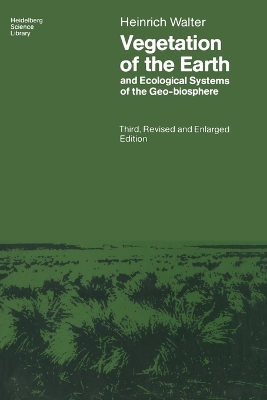Heidelberg Science Library
1 primary work • 3 total works
Book 1
Ecological Systems of the Geobiosphere
by Heinrich Walter and Siegmar-W. Breckle
Published 1 January 1985
In Volume 1 of this four-volume series, ecological problems of a general nature were discussed from a global point of view. Familiarity with this is essential for a full understanding of the more specialized treatment in this and subsequent volumes, for no similar approach is to be found in other ecological handbooks for beginners. This present volume deals in detail with the special ecological relation ships of the tropical and subtropical zonobiomes I to III. Most ecologists proceed from the basis of their experience in the temperate zones of the northern hemisphere. As a result, many ecological writings show a certain one-sidedness and there is a danger that generalizations made will not be broadly applicable. To avoid this, particular emphasis is laid, in this vol urne, on the special ecological features and the characteristics of the trop ical and subtropical regions. More specifically, we deal not only with the relationship of the euclimatope to zonal soils and zonal vegetation, but also pay attention to azonal conditions shown in pedobiomes and in the altitudinal belts of mountains, the orobiomes. In this and the subsequent volumes the same simple scheme is followed in treating each zonobiome: 1. climate; 2. soils; 3. producers; 4. consum ers; 5. decomposers; 6. ecosystems; 7. sub division into biomes; 8. oro biomes; 9. pedobiomes and 10. zonoecotones. Where it has appeared expedient, however, we have occasionally deviated from this scheme (see Deserts D, F, G and H)."
Vegetation of the Earth and Ecological Systems of the Geo-biosphere
by Heinrich Walter
Published 1 January 1985
We shall limit our observations to the conditions in natural ecosystems, since it would be beyond the scope of this book to embark upon a consideration of secondary, man-made ecosystems. 2. Classification of the Geo-biosphere into Zonobiomes The biosphere is the thin layer of the earth's surface to which the phenomena connected with living matter are confined. On land, this comprises the lowest layer of the atmosphere permanently inhabited by living organisms and into which plants extend, as well as the root-containing portion of the lithosphere, which we term the soil. Living organisms are also found in all bodies of water, to the very depths of the oceans. In a watery medium, however, cycling of material is achieved by means other than those on land, and the organisms (plankton) are so different that aquatic ecosystems have to be dealt with separately. The biosphere is therefore subdivided into (a) the geo-biosphere comprising terrestrial ecosystems, and (b) the hydro-biosphere, comprising aquatic ecosystems, which is the field of hydrobiologists (oceanographers and limnologists) . Our studies are confined to the geo-biosphere (Walter 1976), which constitutes the habitat of man and is, therefore, of special interest. The prevailing climate, being the primary independent factor in the environment, can be used as a basis for further subdivision of the geo-biosphere since the formation of soil and type of vegetation are dependent upon it (see p. 3), and it has not yet been substantially influenced by man.

